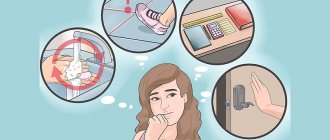Obsessive thoughts (obsessions) are images or impulses that invade consciousness uncontrollably, against a person’s will. Attempts to get rid of these thoughts lead to outbreaks of anxiety and bring severe discomfort. A person experiences constant fears and bad thoughts. If you do not seek help in time, obsessions lead to psychological exhaustion, social withdrawal and depression.
Obsessive thoughts occur in many diseases: neuroses, depression, obsessive-compulsive disorder (obsessive neurosis) and even schizophrenia.
Features that distinguish obsessive thoughts syndrome:
- a person cannot influence the appearance of such thoughts, thoughts arise against desire;
- obsessive thoughts are not connected with a person’s usual thoughts - they are separate, alien images;
- obsessive thoughts syndrome cannot be overcome by willpower;
- the disorder is associated with intense anxiety and irritability;
- clarity of consciousness and critical perception of one’s condition are usually preserved.
The disorder is extremely difficult to bear. Usually a person is aware of what obsessive thoughts mean, understands the irrationality of the images that arise in the head, but cannot fight them. Attempts to stop the appearance of thoughts and the coercive actions associated with them are unsuccessful and lead to even greater distress.
People who suffer from this disorder are not difficult to convince that their obsessive thoughts are unfounded. But this does not help get rid of the problem. Situations repeat themselves over and over again. A necessary step to getting rid of painful conditions is to seek help from a specialist before complications arise.
Obsessive thoughts (obsessions): definition, prevalence
Obsessions are the medical name for unwanted, involuntary thoughts, images or ideas that can become intrusive, upsetting or disturbing to a person;
they are difficult to control or get rid of. Obsessive thoughts often have the nature of overvaluation.
If such thoughts are associated with obsessive-compulsive disorder (OCD), depression, body dysmorphic disorder, they may be persistent. Intrusive thoughts may also be associated with fixation and memory of certain life events, unwanted worries or memories, post-traumatic stress disorder, other anxiety disorders, eating disorders or psychosis.
Although many people have negative or unwanted thoughts of the same type as people with obsessions, the former may voluntarily discard them. Normally, obsessive thoughts are a “fleeting irritation.”
When obsessive thoughts are a symptom of obsessive-compulsive disorder (OCD), people have difficulty ignoring them and may pay excessive attention to them, causing the obsessions to become more frequent and increase anxiety. Attempts to suppress obsessive thoughts often lead to their greater persistence and intensification. Unlike the normal intrusive thoughts that many people experience, the intrusive thoughts associated with OCD can cause increased anxiety.
More than 85% of a clinical sample of patients with OCD have intrusive thoughts.
Most people who suffer from obsessive thoughts do not think they have obsessive-compulsive disorder because they do not experience classic OCD symptoms, such as hand washing. However, epidemiological studies show that intrusive thoughts are the most common type of OCD worldwide.
Intrusive thoughts can arise as a result of a specific event, such as trauma, violence, including (but not limited to) sexual violence. Obsessions can have several causes.
Intrusive thoughts occur in both adults and children, and across all demographic groups. Middle-aged people, since they have to deal simultaneously with environmental stressors, as well as age-related crises, are more susceptible to obsessive thoughts, both accompanied by other anxiety disorders, depression, and without them.
What symptoms characterize obsession?
There are several symptoms of obsessions that are characteristic of a complicated mental disorder:
— Panic fears, vision of a threat to health and life for no reason;
— Stiffness, indecisiveness in actions;
— High level of anxiety associated with low self-esteem;
- Lack of concentration in everyday life.
All these mental manifestations can be expressed in phobias, panic fear, manifestations of depression and depression.
Types of intrusive thoughts
Any recurring anxious thought can become intrusive. However, researchers have divided intrusive thoughts into several main subtypes:
- Thoughts of violence: obsessions with harming oneself or others.
- Thoughts about relationships: obsessions related to doubts, fears or compatibility in (intimate) relationships, thoughts about the other person and the relationship with him in general.
- Religious Thoughts: Obsessions related to morality, ethics, and potential blasphemy in a religious context.
- Sexual thoughts: obsessions related to sexual orientation or deviant sexual behavior.
- Contagion thoughts: Obsessions about being infected by germs, viruses, or diseases.
- Thoughts about responsibility: Obsessions about whether certain actions or inactions directly affect others and whether they create any risks.
- Other obsessions.
Some of these obsessions may begin as mild anxiety. However, over time they turn into painful attempts to overcome them.
Intrusive Thoughts: Link to Anxiety Disorders
There are several types of anxiety disorders that involve obsessive thoughts:
- Most often, intrusive thoughts are a manifestation of obsessive-compulsive disorder, in which obsessions can take the form of unwanted thoughts, images, or impulses. They appear regularly and to suppress, neutralize or control obsessions, people use obsessive actions (compulsions).
- Generalized anxiety disorder: excessive worry and worry in a variety of situations. Obsessive thoughts can relate to many areas of life, including family relationships, professional sphere, health, environment, etc.
- Panic disorder: recurrent panic attacks, fear and obsessive thoughts about when the next panic attack will occur.
- Social anxiety disorder (social phobia): Intrusive thoughts relate to others' perceptions and judgments of the person with obsessions.
- Specific phobia: the experience of anxiety focused on a specific situation, object or thing. Intrusive thoughts are related to security and the perceived threat of its violation.
- Separation anxiety disorder: the experience of anxiety due to the loss of a close relationship with a significant other. Intrusive thoughts are associated with the loss of another person.
- Agoraphobia: the experience of an intense fear of being in certain places or environments, such as enclosed spaces or large crowds of people. Intrusive thoughts are related to safety and well-being, as well as the fear of being trapped or physically harmed.
In addition, intrusive thoughts may co-occur with other mental disorders such as depression ; postpartum depression ; substance use disorders; eating disorders . In this case, obsessive thoughts partially authorize the behavior associated with a mental disorder. Thus, the person remains in a constant cycle of cognitive distortions and harmful behavior.
What is obsession like?
There is a wide range of this type of psychological disorder. The most common manifestations of obsessive ideas are:
- Involuntary conclusions (a person constantly talks about the same thing, regardless of the situation);
— Arithmomania (a person constantly makes arithmetic calculations in his head that are not related to the environment);
— Constant stories about some event, fixation on ideas (you hear from a person the same thought, which should be appreciated by others).
Obsession can often be confused with schizophrenia or other types of psychological disorders. Therefore, experienced psychiatrists should take part in the diagnosis.
In addition to the manifestations described above, a person with this disorder may constantly doubt the correctness of his daily actions.
One example of obsession can be considered a constant desire to curse with obscene words, with or without reason. In practice, there have also been situations where a person had an obsession with making love in public. Regardless of the form in which mental deviation is expressed. What remains important is its cause and degree of neglect.
How to get rid of obsessive thoughts
Stopping obsessive thoughts
Most studies confirm that attempts to stop negative thoughts do not bring the expected results; on the contrary, they intensify obsessions. Therefore, you should focus on rethinking your obsessive thoughts, changing cognitive strategies, and reducing anxiety.
Raise awareness
Thoughts and behavior do not arise by chance. They are the result of deeply ingrained thought patterns or triggers that may or may not be conscious. Being aware of these triggers helps people better manage their reactions. Common triggers include:
- Stress
- Reflections on an event that happened in the past
- Significant life changes (graduation, marriage, birth of a child)
- Receiving bad news (job loss, death of a loved one)
- Sudden and unexpected changes
Changing Thinking Patterns
Most intrusive thoughts are rooted in faulty thinking patterns. Although thoughts may seem realistic and reasonable, all thoughts are always subjective and, accordingly, conclusions are too. Cognitive-behavioral psychotherapy turned out to be the most effective in correcting them .
Coping with fears and anxieties
Behind every obsessive thought lies a strong fear. Fears vary, but they are often based on feelings of loss, abandonment, or general insecurity. These fears are not always completely irrational. Often behind them lies a certain amount of truth, which a person exaggerates so that fear and anxiety become the only reality for him, requiring complete concentration on the threat.
It is worth noting that fear is necessary for all people as an important component of survival; it is what forces people to be alert and active in their environment. Therefore, the goal is not to reduce fear, but to get used to it, figuratively speaking, “train the fear muscle.” Exposure psychotherapy (prevention of exposure and reaction) copes most successfully with this task Please note that it should be used strictly under the supervision of a professional psychotherapist or medical psychologist in order to avoid unforeseen negative effects. This is believed to be the most effective way to reduce the frequency and intensity of intrusive thoughts.
Additionally, mindfulness and acceptance psychotherapy, desensitization, relaxation methods on the recommendation of a psychotherapist or medical psychologist, and other methods can be used.
In this case, individual psychotherapy is often aimed at:
- creating a favorable space for processing psychological trauma, life difficulties and stressors,
- stabilization of the emotional background, development of adequate healthy emotional reactions,
- identifying individual triggers of obsessive thoughts,
- changing reactions to other sources of stress (relationships, work, self-esteem problems, depression, anxiety disorders) that may contribute to maladaptive thinking,
- developing and implementing healthier coping skills,
- increasing self-esteem and building a working model of keeping it at a healthy level;
- changing and practicing a new way of thinking,
- providing a supportive space to process past traumas
- in more complex cases, psychotherapy will be aimed at treating other concomitant mental disorders (anxiety disorder, depression, eating disorder, PTSD, etc.).
Psychotherapy methods are selected individually in each specific case, taking into account symptoms, concomitant disorders, individual characteristics of a person with obsessions, and are recommended at the first psychotherapeutic consultation.
Drug treatment
Pharmacological treatment may temporarily reduce symptoms, but non-pharmacological psychotherapy or a combination of these approaches must be used to achieve long-term remission. A psychotherapist may prescribe antidepressants, anxiolytics, antipsychotics, antipsychotics or other drugs, depending on each specific case. Self-medication is unacceptable, as is the prescription of medications by other specialists (even with medical education) in order to avoid unaccounted negative side effects and aggravation of health problems.









